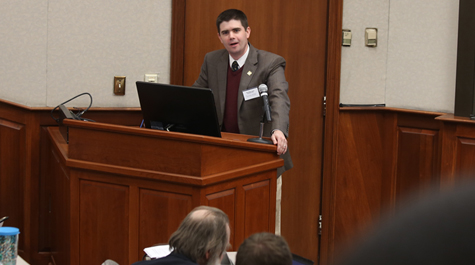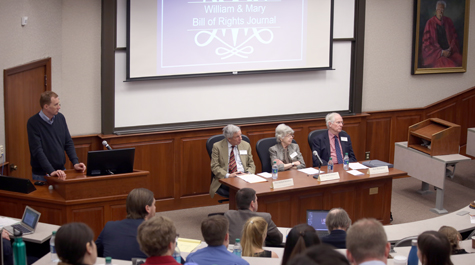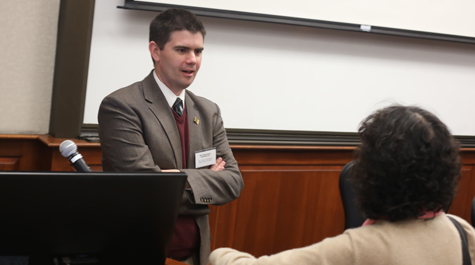Top Medieval Law Scholars Explore Magna Carta’s Legacy at BORJ Symposium
On Friday, March 18, the William & Mary Bill of Rights Journal (BORJ) hosted “After Runnymede: Revising, Reissuing, and Reinterpreting Magna Carta in the Middle Ages.” The day-long symposium explored Magna Carta’s impact between its issuance in 1215 and resurgence in the seventeenth century.
Professor Thomas McSweeney, William & Mary Law School’s resident specialist in the early history of the common law, said that although 2015 represented the 800th anniversary of the foundation of the original document, King John’s death the following year led to important revisions that make 2016 an equally significant anniversary in its formation.
“2016, in a sense, kicks off the anniversary of the later development of Magna Carta, the process by which a failed peace treaty was transformed into a charter of liberties, which became part of both the English and American constitutional traditions,” McSweeney said.
Elaborating on those developments, the symposium offered four panels with world-renowned scholars in medieval legal history from the United Kingdom and North America.The first session, “Magna Carta’s Dissemination,” featured Janet Loengard (Moravian College), Richard Helmholz (University of Chicago), and Paul Brand (University of Oxford), and addressed Magna Carta’s influence upon such topics as the widow’s quarantine, the English Church, and the diffusion of texts in the thirteenth century.
The second panel featured Professor McSweeney and Karl Shoemaker (University of Wisconsin-Madison) delving into the religious dimension of Magna Carta.
The next panel explored the later history of the Charter of the Forest, featuring Ryan Rowberry (Georgia State) and Sarah Harlan-Haughey (University of Maine).
Charles Donahue (Harvard University), Anthony Musson (University of Exeter), and David Seipp (Boston University), rounded up the day with a discussion of Magna Carta in the later Middle Ages. Topics included an investigation of the transformation Magna Carta from law to symbol, and Magna Carta’s role in the “lawless” fifteenth century.
Students appreciated the opportunity the symposium held in providing a glimpse into a significant aspect of legal history.
“History not only helps us to understand why the law is what it is today, but it also forces us to think about what the law can be tomorrow and what role attorneys can play in shaping it,” said Alyssa D’Angelo J.D. ’18. “We learn that the law has never been—and will likely never be—divorced from people, economic systems, and governments.”
D’Angelo added that she is confident that “this lesson will serve us well in practice, where we will be forced to confront the law in context.”
D’Angelo’s classmate Breanna Jensen concurred. “Events like the Magna Carta symposium are important for law students because they provide that historical background that we don’t always have time to cover in class.”
The event was sponsored by William & Mary’s Bill of Rights Journal. Since 1992, the BORJ has published important scholarly works on constitutional law. Published four times per year, the journal is ranked the third most-cited student-edited constitutional law journal by Washington and Lee’s Law Journal Rankings Survey.
About William & Mary Law School
Thomas Jefferson founded William & Mary Law School in 1779 to train leaders for the new nation. Now in its third century, America's oldest law school continues its historic mission of educating citizen lawyers who are prepared both to lead and to serve.


